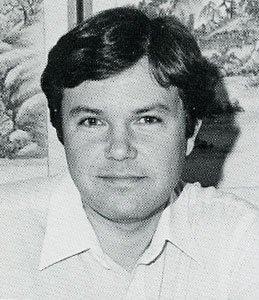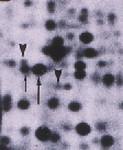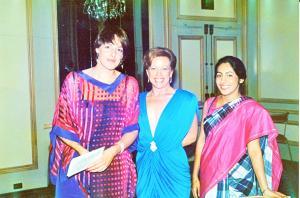
John Leavitt, 1982.
[Guest post written by John Leavitt, Ph.D., Nerac, Inc., Tolland, CT.]
In the fall of 1985, I went to a small meeting in Heidelberg, Germany, with Steve Burbeck from the Linus Pauling Institute of Science and Medicine, who had helped me by developing computerized microdensitometry to analyze two-dimensional protein profiles. At this meeting I described our protein profiling work and the discovery of the mutant beta-actins and another interesting protein which I named “plastin.”
Steve Kent, head of the protein sequencing facility in Leroy Hood’s lab at Caltech, heard my talk. We sat across from each other at dinner and he proposed a collaboration to develop methods of sequencing minute amounts of protein leached from spots in high resolution protein profiles. Lee Hood was well known for developing state-of-the-art protein and nucleic acid sequencing methods and machines, and was a founder of Applied Biosystems in Foster City, CA.
After I returned from Heidelberg, Ruedi Aebersold called me from Caltech and we began collaborating on microsequencing of pure nanomolar quantities of unknown proteins of interest eluted out of my protein profiles. In this work we essentially started the field of proteomics, which was eventually named ten years later by Jim Garrells, a protein profiler at Cold Spring Harbor. Proteomics is the search for and definition of proteins that could serve as diagnostic markers and drug targets for diagnosis and treatment of diseases, in our case cancer.
In 1987 we published a landmark paper in PNAS on the microsequencing technique that Ruedi developed. This paper would eventually be cited in references by more than 1,000 other research papers.

I gave a postdoctoral fellow, Mahdu Varma, the task of isolating the cancer-specific leukocyte isoform of plastin (L-plastin) from 140 protein profiles. This protein has been implicated in metastases in both melanoma and prostate cancer as well as in other aspects of cancer. The L-plastin spot was easily recognized and those spots on a nitrocellulose filter were “snipped out,” removing all the other proteins of the cell. We sent Ruedi a plastic tube containing the 140 “spots” of L-plastin. He had figured out a way to solubilize the protein from the nitrocellulose and was successful in determining the sequence of eight oligopeptides of between eight and sixteen amino acids derived by digestion of L-plastin with a proteolytic enzyme.
The peptide sequences he determined turned out to be perfectly accurate internal amino acid sequences of plastin when we decoded the sequence of the plastin gene (cDNA) clone, a reverse transcript of the messenger RNA. This was the first time that anyone had done this and it opened up the field of proteomics and led to the discovery of other diagnostic and drug targets.

We had chosen L-plastin, normally only expressed in white blood cells, because I had reported for years that it was a cancer marker in tumors that arose in solid tissues (identified in the image above by the two upward arrows). After we received the oligopeptide sequences from Ruedi, we made short DNA antisense probes that would hybridize to DNA sequences encoding these peptides in the human genome to fish out the full-length DNA clones that carried the sequence of the L- plastin gene.
Ching Lin and I, along with Reudi, published the sequences of the human L- and newly discovered T-plastin proteins, based upon sequencing of cDNAs, in Molecular and Cellular Biology. The discovery of a second isoform of plastin (T-plastin named for tissue plastin as opposed to L-plastin from leukocytes) was a surprise. We now had two genes to characterize at the genomic level. Today, T-plastin is a well recognized marker for cutaneous T-cell lymphoma (Sezary Lymphoma) and L-plastin, inappropriately expressed in solid tumor cells (carcinomas, fibrosarcomas, etc.), is understood to be a contributor to metastasis.
The Linus Pauling Institute was not all work and no play in the 1980s
We worked hard at the Institute and Linus Pauling was always there and visible.
We put together a softball team with Jim Fleming, Dan McQueeny, Zelek Herman, myself, and others at the Institute and played departmental teams at Stanford. I think we were called the “Pauling squeeze.” After these games we would often go dancing at the Class Reunion on El Camino Real near the corner of Page Mill Road.
We were fortunate to have on staff a first rate fundraiser in Richard (Rick) Hicks who arranged wonderful parties on Nob Hill at the Stanford Court. The most memorable of these parties occurred in late November 1986, when we honored Japanese billionaire Ryoichi Sasakawa with the annual Linus Pauling Medal. Another year Carl Sagan and Ann Druyan, who helped Carl put together the Cosmos series, likewise took part. We often saw Dr. Pauling’s sons, Linus Pauling Jr., Peter, and Crellin as well.

Here we are at the Stanford Court that night with postdoctoral fellows, Dr. Karin Sturm from Heidelberg, Germany, on the left and Dr. Madhu Varma from Madras, India, on the right. My wife, Becki, is in the middle. I recall that Dr. Pauling enjoyed this night as well.
In 1988 I moved on to a new position in San Jose and then became Director of Research at Adeza Biomedical. Since we continued to live in Palo Alto, we continued to interact and party with the Linus Pauling Institute staff into the 1990s.
